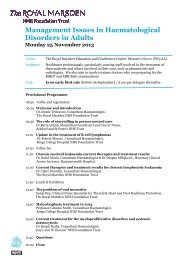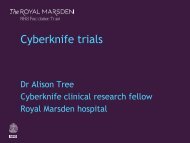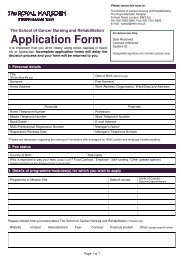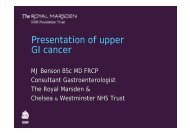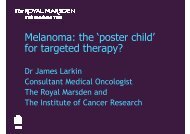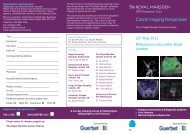Download presentation (PDF) - Royal Marsden Hospital
Download presentation (PDF) - Royal Marsden Hospital
Download presentation (PDF) - Royal Marsden Hospital
Create successful ePaper yourself
Turn your PDF publications into a flip-book with our unique Google optimized e-Paper software.
4The <strong>Royal</strong> <strong>Marsden</strong>Basal cell carcinoma– Most common cutaneous malignancy– Incidence increasing– Risk factors:– Age– Male– Chronic sun exposure– Immunosuppression– Previous radiotherapy– Rare – Gorlins syndrome, xeroderma pigmentosa
5The <strong>Royal</strong> <strong>Marsden</strong>Clinical features– Four main subtypes– Nodular or ulcerative 45-60%– Diffuse (infiltrating and morphoeic) 4-17%– Superficial (multifocal) 15-35%– Pigmented 1-7%
7The <strong>Royal</strong> <strong>Marsden</strong>Seborrhoeic Keratoses– Benign– 30s onwards– Inherited– Trunk, face– Eruptive (Leser Trelat)
8The <strong>Royal</strong> <strong>Marsden</strong>Squamous cell carcinoma– 20% cutaneous tumours – head and neck– Incidence rising– Risk factors– Age– Male– Chronic sun exposure– Previous radiotherapy– HPV (16 and 18)– Chronic ulcers – Marjolins– Immunosuppression/ HIV– Rare – Xeroderma pigmentosa
9The <strong>Royal</strong> <strong>Marsden</strong>Immunosuppression – Transplant patientsRatio SCC: BCC reversedMore aggressive tumoursOften painfulOften look quite banal
10The <strong>Royal</strong> <strong>Marsden</strong>Precursor lesionsActinic keratoses– 25% remit spontaneously, 2% go on to NMSCSCC in situ– BowensArsenical keratosesChronic radiation keratoses
11The <strong>Royal</strong> <strong>Marsden</strong>Clinical features– Indurated plaques– Tumid lesions– Verrucous– Ulcerated– Hyperkeratotic/warty/cutaneous horns
12The <strong>Royal</strong> <strong>Marsden</strong>Differential diagnosis– Keratoacanthomas– BCC– Actinic Keratoses– Viral wart– Seborrhoeic Keratoses
13The <strong>Royal</strong> <strong>Marsden</strong>Malignant melanomaWorldwide number of cases is increasing faster thanany other cancer
14The <strong>Royal</strong> <strong>Marsden</strong>Malignant melanoma– 2000 deaths per year in the UK– 10,000 cases per year– Commonest cancer in 15 to 34 year olds– Increasing faster than any other cancer
15The <strong>Royal</strong> <strong>Marsden</strong>Aetiology - Sun exposure– Sun exposure in childhood is a major risk factor– Recent study has shown that sun burn later on in life alsoincreases risk– Intermittent exposure + blistering sun burn– Sunbeds
16The <strong>Royal</strong> <strong>Marsden</strong>Clinical historyRecent history of change– New naevus– Longstanding naevus
17The <strong>Royal</strong> <strong>Marsden</strong>Diagnosis - Glasgow seven point checklistMajor featuresMinor features– change in size– irregular shape– irregular colour– largest diameter 7mm ormore– inflammation– oozing– change in sensation
18The <strong>Royal</strong> <strong>Marsden</strong>ABCDEABCDEAsymmetryBorder irregularityColour variationDiameter over 6 mmEvolving (enlarging, changing)
19The <strong>Royal</strong> <strong>Marsden</strong>Examination– Skin type– Freckling, red hair– Evidence of sun damage– Lots of naevi– The ‘ugly duckling’ sign
20The <strong>Royal</strong> <strong>Marsden</strong>Aetiology - host factors– Atypical Naevi– >5mm diameter– irregular– variegate pigmentation– Atypical naevus syndrome
21The <strong>Royal</strong> <strong>Marsden</strong>Melanoma clinical typesSuperficial spreading90%Lentigo maligna3%Nodular melanoma5%Acral lentiginous2%
22The <strong>Royal</strong> <strong>Marsden</strong>Dermoscopy– To identify a melanocytic lesion
23The <strong>Royal</strong> <strong>Marsden</strong>Examination - dermoscopy– Dermoscopy refers to the examination of the skin using skinsurface microscopy, and is also called ‘dermatoscopy’,‘epiluminoscopy’ and ‘epiluminescent microscopy’.– Dermoscopy is mainly used to evaluate pigmented skinlesions.– In experienced hands it can make it easier to diagnosemelanoma
24The <strong>Royal</strong> <strong>Marsden</strong>Examination - dermoscopy
25The <strong>Royal</strong> <strong>Marsden</strong>Dermoscopy – 3 point checklist– 1. Asymmetry– 2. Atypical network – irregular holes and thick lines– 3. Blue white structures– Two out of three = positive = excise
26The <strong>Royal</strong> <strong>Marsden</strong>Examination - Dermoscopy– Often more helpful to reassure you it’s benign– Some studies shown better than naked eye examination – notconsistent– Reduces excision of benign lesions– If clinically suspicious and ‘normal’ examination consider maybe a melanoma excise anyway.
27The <strong>Royal</strong> <strong>Marsden</strong>When to consider the diagnosis of melanomaHistory of change– One of the three Major criteria of the Glasgow 7 point checklist– High risk factors – AMS, FHx– Examination – ‘ugly duckling’, dermoscopic changes– Can’t exclude a melanoma
28The <strong>Royal</strong> <strong>Marsden</strong>Thank you!





